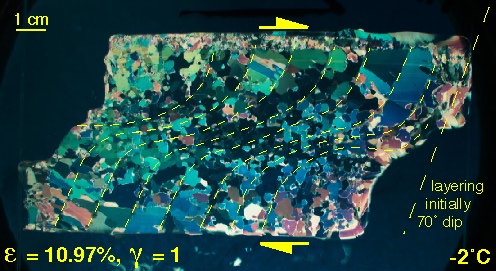FLOW IN POLYCRYSTALLINE ICE
Part 2 - Background information
By Chris Wilson and Brett Marmo
2.18 Grain growth
The average grain-size of a population of deformed crystals in any highly deformed aggregates tends to increase with time. Grain growth is driven by neighbouring grains that possess different energy levels due to the curvature of energetic grain boundaries and/or different amounts of accumulated strain energy. A change in the average grain-size of a polycrystalline aggregate has significant implications for the way the body deforms, as diffusional flow and grain boundary sliding are grain-size dependent. Under certain stress and temperature conditions a progressive increase in grain-size can move the ice from diffusion flow controlled creep to glide controlled creep and from ductile deformation to brittle deformation (Cole 1985).
Surface tension across a curved boundary between two grains gives rise to a pressure difference, with the grain that possesses the concave boundary having a higher energy state. Molecules tend to move from the high energy side of the boundary to the low energy side. This leads to grain boundary migration as the low energy crystal consumes the high energy crystal (Alley 1992). The process decelerates with time because the size of the high energy crystal is reduced which increases the curvature of the boundary and the differential energy between to the two grains. Grain growth driven by curvature of boundaries would continue indefinitely if it were not for the presence of impurities, dust and bubbles which pin grain boundary migration (Alley et al. 1986).
Dislocations and other defects that stem from deformation of a crystal lattice, increase a grain's disorder and internal energy. When a boundary separates a strained crystal from an unstrained crystal, the free energy of the strained crystal is higher. The grain boundary begins to migrate to reduce the total energy of the system, with molecules moving from the strained grain to the unstrained grain. Once this process has begun it will tend to continue as the ice on the unstrained side is newer, more ordered and has a lower energy that the strained crystal (Alley et al. 1986). Eventually the strained grain is reduced in size to the extent that curved boundary effects become significant and the strained grain is rapidly consumed. In this manner the deformed grains are removed from the ice and the average grain-size is increased with time.
While grains are consumed by boundary migration, they can also be created by recrystallisation and polygonisation. Polygonisation is the subdivision of large grains into smaller grains and is driven by different parts of a crystal being subjected to different stress states. The variation in the stress field can lead to a lattice becoming warped or to the development of kink bands orthogonal to the basal plane. Dislocations tend to accumulate at kinks in the lattice which then become the sites for dynamic recrystallisation and the division of crystals into sub-grains (Wilson 1986). Initially subgrains have a small mis-match in crystallographic orientation, but continued deformation leads to rotation of grains and the refinement of boundaries between subgrains. This process is referred to as rotation recrystallisation (Poirier 1985) and leads to the subgrains becoming distinctly different crystals.
Figure 2.19.1: Grain size reduction occurs in a shear zone developed in coarse ice deformed at -2°C. A compression (applied to the upper surface) and simple shear are applied simultaneously with the shear strain confined to a ~15mm wide zone, bounded by undeformed region. Within the shear zone there is rotation of the pre-existing foliation and substantial grain size reduction.
